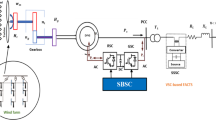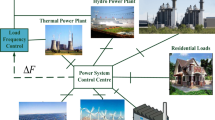Abstract
This paper introduces a new robust controller with cascaded fuzzy blocks as a power system stabilizer (CFPSS) to enhance damping during low-frequency oscillations. This CFPSS is designed to act as a nonlinear lead–lag PSS with a given number of compensation blocks. To demonstrate the efficiency and the robustness of this proposed stabilizer, simulation results performed on the IEEE three-generator nine-bus multi-machine power system subjected to a three-phase short-circuit fault have been carried out. The parameters of the proposed PSS and those of the conventional IEEE linear lead–lag PSS have been tuned by a recently developed optimization technique (krill herd algorithm). The robustness of this novel CFPSS is proved, by optimizing the parameters of the two PSSs for one operating point (normally loaded system) and applying them to other operating points (case of heavy and low loads) with some key parameters variation. The obtained results have shown the superiority and the robustness of the CFPSS comparatively to the conventional IEEE lead–lag PSS in terms of oscillations damping over a wide range of operating conditions and against parametric variation. The same conclusions have been drawn in the case of a large power system (IEEE 16-machine, 68-bus test system) characterized by its local and inter-area oscillations modes.












Similar content being viewed by others
References
Abido, M. A. (2002). Optimal design of power system stabilizers using particle swarm optimization. IEEE Transactions on Energy Conversion, 17(3), 406–413.
Abido, A., & Abdel-Magid, L. (2002). Optimal design of power system stabilizers using evolutionary programming. IEEE Transactions on Energy Conversion, 17(4), 429–436.
Aboul-Ela, M. E., Sallam, A. A., McCalley, J. D., & Fouad, A. A. (1996). Damping controller design for power system oscillations using global signals. IEEE Transactions on Power Systems, 11(2), 767–773.
Ali, E. S. (2014). Optimization of power system stabilizers using BAT search algorithm. Electrical Power and Energy Systems, 61, 683–690.
Anderson, P. M., & Fouad, A. A. (2008). Power system control and stability. New York: Wiley.
Boukarim, G. E., Wang, S., Chow, J. H., Taranto, G. N., & Martins, N. (2000). A comparison of classical, robust and decentralized control designs for multiple power system stabilizers. IEEE Transactions on Power Systems, 15(4), 1287–1292.
Chatterjee, A., Ghoshal, S. P., & Mukherjee, V. (2011). Chaotic ant swarm optimization for fuzzy-based tuning of power system stabilizer. International Journal of Electrical Power & Energy Systems, 33, 657–672.
Chitara, D., Swarnkar, A., Gupta, N., et al. (2015). Optimal tuning of multimachine power system stabilizer using cuckoo search algorithm. IFAC, 48(30), 143–148.
Choucha, A., Hellal, A., Mokrani, L., & Arif, S. (2012). New approach to the optimization of power system stabilizers: Genetic algorithm with dynamic constraints. Control and Intelligent Systems, 40(3), 129–143.
De Menezes, M. M., de Araujo, P. B., & do Valle, D. B. (2016). Design of PSS and TCSC damping controller using particle swarm optimization. Journal of Control, Automation and Electrical Systems, 27(5), 554–561.
De Oliveira, R. V., Ramos, R. A., & Bretas, N. G. (2010). An algorithm for computerized automatic tuning of power system stabilizers. Control Engineering Practice, 18, 45–54.
De Vargas Fortes, E., de Araujo, P. B., & Macedo, L. H. (2016a). Coordinated tuning of the parameters of PI, PSS and POD controllers using a specialized Chu–Beasley’s genetic algorithm. Electric Power Systems Research, 140, 708–721.
De Vargas Fortes, E., de Araujo, P. B., Macedo, L. H., Gamino, B. R., & Martins, L. F. B. (2016b). Analysis of the influence of PSS and IPFC-POD controllers in small-signal stability using a simulated annealing algorithm. In 2016 12th IEEE international conference on industry applications (INDUCSON), Curitiba.
De Vargas Fortes, E., Macedo, L. H., de Araujo, P. B., & Romero, R. (2018). A VNS algorithm for the design of supplementary damping controllers for small-signal stability analysis. International Journal of Electrical Power & Energy Systems, 94, 41–56.
Demello, F. P., & Concordia, C. (1969). Concepts of synchronous machine stability as effected by excitation control. IEEE Transactions on Power Apparatus and Systems, 88(4), 316–329.
Eke, I., Taplamacioglu, M. C., & Lee, K. Y. (2015). Robust tuning of power system stabilizer by using orthogonal learning artificial bee colony. IFAC, 48(30), 149–154.
Elazim, S. A., & Ali, E. S. (2016). Optimal power system stabilizers design via cuckoo search algorithm. International Journal of Electrical Power Energy System, 75, 99–107.
El-Zonkoly, A. M., Khalil, A. A., & Ahmied, N. M. (2009). Optimal tuning of lead–lag and fuzzy logic power system stabilizers using particle swarm optimization. Expert Systems with Applications, 36, 2097–2106.
Esmaili, M. R., Khodabakhshian, A., GhaebiPanahc, P., & Azizkhanid, S. (2013). A new robust multi-machine power system stabilizer design using quantitative feedback theory. Procedia Technology, 11(1), 75–85.
Feliachi, A., Zhang, X., & Sims, S. C. (1988). Power system stabilizers design using optimal reduced order models. Part II: design. IEEE Transactions on Power Systems, 3(4), 1676–1684.
Fraile-Ardanuy, J., & Zufiria, P. J. (2007). Design and comparison of adaptive power system stabilizers based on neural fuzzy networks and genetic algorithms. Neurocomputing, 70(2), 902–912.
Gandomi, A., & Alavi, A. (2012). A new bio inspired optimization algorithm. Communications in Nonlinear Science and Numerical Simulation, 17(12), 4831–4845.
Ghosh, A., Ledwich, G., Malik, O. P., & Hope, G. S. (1984). Power system stabilizer based on adaptive control techniques. IEEE Transactions on Power Apparatus and Systems, 103, 1983–1986.
Ghoshal, S. P., Chatterjee, A., & Mukherjee, V. (2009). Bio-inspired fuzzy logic based tuning of power system stabilizer. Expert System Applications, 36(5), 9281–9292.
Hardiansyah, F. S., Furuya, S., & Irisawa, J. (2006). A robust H∞ power system stabilizer design using reduced-order models. Electrical Power Energy Systems, 28, 21–28.
Jebali, M., Kahouli, O., & Hadj Abdallah, H. (2017). Optimizing PSS parameters for a multi-machine power system using genetic algorithm and neural network techniques. International Journal of Advanced Manufacture and Technology, 90, 2669–2688.
Jilledi, S. K. (2017). Improving profile parameters of the power system network using krill heard algorithm with facts device: UPFC. Global Journal of Researches in Engineering, 17(3), 1–13.
Kundur, P. (1994). Power system stability and control. New York: McGraw-Hill.
Kundur, P., Klein, M., Rogers, G. J., & Zywno, M. S. (1989). Application of power system stabilizers for enhancement of overall system stability. IEEE Transactions on Power Systems, 4(2), 614–626.
Kvasov, D., Menniti, D., Pinnarelli, A., Sergeyev, Y., & Sorrentino, N. (2008). Tuning fuzzy power-system stabilizers in multi-machine systems by global optimization algorithms based on efficient domain partitions. Electrical Power System Research, 78(7), 1217–1229.
Larsen, E. V., & Swann, D. A. (1981). Applying power system stabilizers: parts I, II and III. IEEE Transactions on Power Apparatus and Systems, 100(6), 3017–3046.
Lee, S. S., & Park, J. K. (1998). Design of power system stabilizer using observer/sliding mode, observer/sliding mode model following and H∞/sliding mode controllers for small signal stability study. Electrical Power & Energy Systems, 20(8), 543–553.
Li, Q., & Liu, B. (2017). Clustering using an improved krill herd algorithm. MDPI Journal, 10(2), 1–12.
Lin, Y. J. (2013). Proportional plus derivative output feedback based fuzzy logic power system stabilizer. Electrical Power and Energy Systems, 44(1), 301–307.
Mamdani, E. H. (1974). Applications of fuzzy algorithms for control of simple dynamic plant. Proceedings of the IEE Control & Science, 121(12), 1585–1588.
Martins, L. F. B., de Araujo, P. B., de Vargas Fortes, E., & Macedo, L. H. (2017). Design of the PI–UPFC–POD and PSS damping controllers using an artificial bee colony algorithm. Journal of Control, Automation and Electrical Systems, 28(6), 762–773.
Mekhanet, M., Mokrani, L., Ameur, A., & Attia, Y. (2016). Adaptive fuzzy gain of power system stabilizer to improve the global stability. Bulletin of Electrical Engineering and Informatics, 5(4), 421–429.
Miotto, E. L., de Araujo, P. B., Gamino, B. R., Fortes, E. D. V., & Martins, L. F. B. (2016). Coordinated tuning of the parameters of supplementary controllers damping using bio-inspired algorithms. In 2012 12th IEEE international conference on industry applications (INDUCSON), Curitiba.
Mishra, S., Tripathy, M., & Nanda, J. (2007). Multi-machine power system stabilizer design by rule based bacteria foraging. Electrical Power System Research, 77, 1595–1607.
Pai, M. A., Sen Gupta, D. P., & Padiyar, K. R. (2004). Small signal analysis of power systems (1st ed.). New Delhi: Narosa Publishing House.
Panda, S., & Padhy, N. P. (2008). Robust power system stabilizer design using particle swarm optimization technique. International Journal of Electrical and Computer Engineering, 2(10), 2260–2267.
Park, Y. M., & Kim, W. (1996). Discrete time adaptive sliding mode power system stabilizer with only input/output measurements. Electrical Power & Energy Systems, 18, 509–517.
Ramos, R. A., Alberto, L. F. C., & Bretas, N. G. (2004). A new methodology for the coordinated design of robust decentralized power system damping controllers. IEEE Transactions on Power Systems, 19(1), 444–454.
Rogers, G. (2000). Power system oscillations (pp. 314–317). Boston, MA: Kluwer.
Sambariya, D. K., Gupta, R., & Prasad, R. (2016). Design of optimal input-output scaling factors based fuzzy pss using bat algorithm. Engineering Science and Technology, an International Journal, 19(2), 991–1002.
Sambariya, D. K., & Rajeev, G. (2010). Fuzzy applications in a multi-machine power system stabilizer. Journal of Electrical Engineering & Technology., 5(3), 503–510.
Segal, R., Sharma, A., & Kothari, M. L. (2004). A self-tuning power system stabilizer based on artificial neural network. International Journal of Electrical Power Energy System, 26(6), 423–430.
Sugeno, M., & Kang, G. T. (1989). Structure identification of fuzzy model. Fuzzy Sets and Systems, 28, 15–33.
Takagi, T., & Sugeno, M. (1985). Fuzzy identification of systems and its applications to modeling and control. IEEE Transactions on Systems, Man and Cybernetics, 15(1), 116–132.
Wang, H., & Du, W. (2016). Analysis and damping control of power system low-frequency. Boston: Springer.
Wenyan, Gu, & Bollinger, K. E. (1989). A self-tuning power system stabilizer for wide-range synchronous generator operation. IEEE Transactions on Power Systems, 4(3), 1191–1199.
Yuan-Chyuan, L., & Chi-Jui, W. (1995). Damping of power system oscillations with output feedback and strip eigenvalue assignment. IEEE Transactions on Power Apparatus and Systems, 10(3), 1620–1626.
Zadeh, N. H., & Kalam, A. (1999). A direct adaptive fuzzy power system stabilizer. IEEE Transactions on Energy Conversion, 14(4), 1564–1571.
Zhu, C., Khammash, M., Vittal, V., & Qiu, W. (2003). Robust power system stabilizer design using H∞ loop shaping approach. IEEE Transactions on Power Systems, 18(2), 810–818.
Author information
Authors and Affiliations
Corresponding author
Additional information
Publisher’s Note
Springer Nature remains neutral with regard to jurisdictional claims in published maps and institutional affiliations.
Rights and permissions
About this article
Cite this article
Douidi, B., Mokrani, L. & Machmoum, M. A New Cascade Fuzzy Power System Stabilizer for Multi-machine System Stability Enhancement. J Control Autom Electr Syst 30, 765–779 (2019). https://doi.org/10.1007/s40313-019-00486-7
Received:
Revised:
Accepted:
Published:
Issue Date:
DOI: https://doi.org/10.1007/s40313-019-00486-7




